León is an etching from 1923 by American artist, John Taylor Arms. It is pencil signed and dated and dedicated “To John and Nora [Winkler], in memory of days in Paris.” The reference is Fletcher 140 and the edition was 150 plus proofs. León was printed by Frederick Reynolds on an ivory laid paper with a crown watermark. The platemark measures 7-1/4 x 11-3/8 inches.
León was the first in Arms' Spanish Churches Series of fifteen plates. León, a city on the Bernesga River in northwest Spain, is the capital of the Province of León. It is home to many churches and cathedrals, but here Arms depicted the ancient buildings of the city, contrasted to the looming thirteenth-century Gothic Santa María de Regla de León Cathedral. The cathedral with its towers, flying buttresses, and stained-glass windows, is considered one the of the greatest works of the Gothic style. León is also noted for the nineteenth-century Casa Botines, designed by Spanish architect, Antoni Gaudi.
Arms wrote of his love for architecture: “A building possesses truly as does a human being, a skeleton, a covering of flesh, and clothing with which both are in turn covered, so also, and most poignantly, does it possess a spirit.”
John Taylor Arms, printmaker, lecturer, illustrator, and administrator, was born in Washington, D.C. on 19 April 1887. He first studied law at Princeton University but transferred to the Massachusetts Institute of Technology to study architecture, earning a Master’s Degree in 1912. He studied with Ross Turner, David A. Gregg, and Felton Brown. For five years after his graduation Arms worked for the architectural firms Carrere and Hastings, and Clark and Adams before establishing his own architectural firm of which he was a partner.
A gift of an etching kit from his wife, Dorothy, changed the course of his life. He produced his first etching in 1915 and he eventually produced 441 prints, mostly etchings. Arms became one of the most famous printmakers of the first half of the twentieth century. He is mostly noted for his etchings of medieval architecture but early subjects also included ships, sailboats, airplanes, rural landscapes, and the streets, buildings, and bridges of New York.
Arms’ exhibition history was lengthy beginning in 1927 and continuing to 1952. He was given an honorary M.A. degree from Wesleyan University in 1939, and he was a member of the National Academy of Design; the Canadian Painters, Etchers and Engravings; the Royal Society of Painters, Etchers and Engravers; the Society of American Graphic Artists (served as the society's president); the National Institute of Arts and Letters; the American Federation of Arts; the American Artists Professional League; the Architectural League of New York; the Southern States Art League; the Southern Print Makers; the American Color Print Society; the North Shore Art Association; the Washington Water Color Club; the Chicago Society of Etchers; and the Cleveland Print Club.
He authored Hand-Book of Print Making and Print Makers in 1934 and illustrated Churches of France and Hills Town and Cities of Northern Italy by Dorothy Arms.
Arms was an activist for printmaking and assisted in assembling exhibitions of American graphic art that were shown in Sweden, Czechoslovakia and Rome; he was editor of the Print Department of Print, A Quarterly Journal of the Graphic Arts, and he lectured on the techniques, history and value of original prints. Arms also served as the president of the Tiffany Foundation in 1940.
The New York Public Library is the major repository of Arms’ work, but he is also represented in the collections of the Museum of Fine Arts Boston, Massachusetts; the Brooklyn Museum, New York; the Fogg Museum of Art, Harvard University, Cambridge, Massachusetts; the Art Institute of Chicago, Illinois; the Cleveland Museum of Art, Ohio; the Detroit Institute of Arts, Michigan; the Amon Carter Museum of American Art, Fort Worth, Texas; the British Museum and the Victoria and Albert Museum, London; the Los Angeles County Museum, California; the Metropolitan Museum of Art, the National Academy of Design, and the Whitney Museum of American Art, New York; the Fine Arts Museums of San Francisco, California; the Seattle Art Museum, Washington; the Library of Congress and the Smithsonian American Art Museum; Washington, D.C.; and the Worcester Art Museum, Massachusetts.
John Taylor Arms died in New York City on 15 October 1953.



